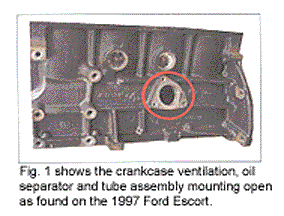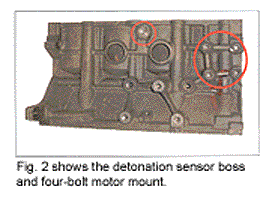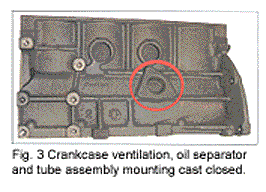Unless you maintain the correct Focus on the engine blocks being used for Ford 2.0L SOHC applications beginning in 1997 you could certainly end being Escort-ed down the wrong path and ending up in that awful position of a “do over.”
In fact the block choices per application remind me of the “Mounds” and “Almond Joy” candy bars: sometimes you feel like a nut sometimes you don’t; only in this case sometimes you have crankcase ventilation open and sometimes you don’t.

So let’s take a look at what we have found to this point and see if it helps keep you out of trouble. In 1997 the Ford Escort used block-casting number F7CE-AB that has a substantial size hole and 3-bolt boss mounting for a crankcase ventilation breather, oil separator and tube assembly which is assembled on to the left side of the block (See Figure 1). On the right side of the block there are four bolt bosses used for the motor mount and near the center of the block close to the deck there is not a provision for a detonation sensor (See Figure 2, above).
In 1998 through 1999 block casting F8CE-AA came onto the scene and the only real change was the addition of the detonation sensor boss (See Figure 2). Then in 2000 things got a little more interesting; the Focus came on the scene, as did another block casting YS4E-AC that actually can be in three different configurations. The Focus used a different cylinder head than the Escort (a whole other topic of discussion) one of those differences is in the front of the cylinder head where the torsional motor mount is attached. 
Since the Focus does not require the four motor mount bolts as seen in Figure 2 above, the YS4E-AC block may or may not have the bolt bosses present, or they may be present and not drilled and tapped, or they may be present, drilled and tapped for use in the Escort application. In addition this same block may have the crankcase vent hole cast open or shut (Figure 3).
The Focus application never used the vent hole open and the Escort did only into the 2000 model year, yet sometime during 2000 it was eliminated. According to the notations in the Ford parts fiche 12/1/1999 was the date for the “emergent hole change” as it is put. So the best guess is that the early 2000 production had the vent hole and the later production did not.
In 2001 block casting YS4E-DA appeared, and it appears to be the common block for both Escort and Focus. It does not have the crankcase ventilation open, it does have a detonation sensor boss, and it does have the four bolt bosses for the side motor mount although only used in the Escort.
So in review, regardless of the block casting numbers, 1997 Escort does not use a detonation sensor, but has an open crankcase ventilation hole and uses the four side motor mount bosses. 1998 through early 2000 Escorts require the detonation sensor boss; four bolt motor mounts, and an open crankcase vent hole. In later 2000 on up, Escort no longer uses the vent hole, requires a det sensor boss and four bolt motor mount. The 2000 and newer Focus uses the det sensor boss, does not require an open vent hole and does not require the four bolt motor mount boss.
As you can see actual casting number identification becomes less of a criterion than the configuration. If you know the configuration based upon the platform application the casting number almost becomes meaningless. Welcome to the new millennium.

One last note, the keen eye of a reader pointed out an incorrect part number listing in the March “Core Corner” about the “inny” and “outy” camshafts for the 3.1L and 3.4L Chevrolet engine. On page 20 in the last paragraph, the part number listed 24597450 is incorrect in fact it does not even exist and should be p/n 24505674.
For more information on casting identification and now Bill of Materials for engine applications visit www.EngineDataSource.com and take a tour. The official release date will be Oct. 1, 2004.
For technical questions, contact the Production Engine Remanufacturers Association (PERA) at: [email protected]













